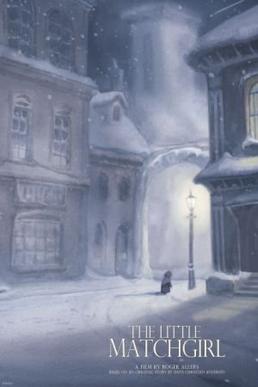The Little Matchgirl (2006 film) facts for kids
Quick facts for kids The Little Matchgirl |
|
|---|---|
 |
|
| Directed by | Roger Allers |
| Produced by | Don Hahn Baker Bloodworth |
| Screenplay by | Roger Allers Kevin L. Harkey Ed Gombert Mark Walton Ralph Zondag |
| Editing by | Jessica Ambinder Rojas |
| Studio | Walt Disney Animation Studios Walt Disney Pictures |
| Distributed by | Buena Vista Pictures Distribution |
| Release date(s) | July 7, 2006 |
| Running time | 7 minutes |
| Country | United States |
The Little Matchgirl is a short animated film from 2006. It was made by Walt Disney Animation Studios and released by Walt Disney Pictures. The film was directed by Roger Allers and produced by Don Hahn. It is based on a famous story called The Little Match Girl, written in 1845 by Hans Christian Andersen. This film was the fifth time Disney adapted one of Andersen's tales. It was even nominated for an Academy Award for Best Animated Short Film, a big award in movies.
Contents
What Happens in the Film?
The film tells its story without words, using only music. The music is a beautiful piece called "Nocturne" from a string quartet by Alexander Borodin.
A Cold Christmas Night
The story takes place during Christmas in Saint Petersburg, Russia. This was a long time ago, before the Russian Revolution. A very poor girl tries to sell matchsticks on the snowy streets. But no one buys any matches from her.
Visions from the Flames
Later that night, the girl is freezing in a snowy alley. She decides to light some of her matches to get warm. As the first match burns, she sees a warm fire in its flame. But when the match goes out, she is back in the cold alley. She lights another match and sees a delicious meal. With the next match, she sees her loving grandmother under a Christmas tree.
A Touching Ending
The next morning, the girl is still in the alley, covered in snow and not moving. Suddenly, her grandmother appears and gently lifts her up. The music becomes very strong and happy. Then, we see that the grandmother is actually a spirit. They pass through a wall together and disappear. As their light fades, the girl's body is still in the snow, but she has a smile on her face. A bright comet flies across the sky, showing that the girl has found peace.
How the Film is Different from the Book
The original story by Hans Christian Andersen was written to show how hard life was for poor children in Europe. The Disney film is very similar to the book, but there are a few small changes.
Setting and Characters
The film's setting was moved from Andersen's home country, Denmark, to Russia. The director, Roger Allers, thought Saint Petersburg would look beautiful with its snow and harsh winters. The film also does not show the girl's mean father. It also does not directly show her grandmother dying, but it suggests it at the end. Disney leaders at first wanted a happier ending, but they decided to keep the sad but touching ending.
How the Film Was Made
The director, Roger Allers, and producer, Don Hahn, had worked on many famous Disney films before. These include The Little Mermaid, Beauty and the Beast, Aladdin, and The Lion King.
Animation Style
This short film was originally planned to be part of a movie called Fantasia 2006. Because of this, it was made in the style of Fantasia. This means it tells a story visually, without talking, using only classical music. The film was also the last time Disney used its special computer animation system called CAPS.
Music Choice
The film was first going to use music by Debussy called "Claire de Lune." But Roger Allers decided to use the "Nocturne" from String Quartet No. 2 in D Major by Alexander Borodin. This music reminded him of Russia, which led to the decision to set the film in old Russia. Borodin was even born in Saint Petersburg! The music in the film was played by the Emerson String Quartet.
Release Information
The Little Matchgirl first showed at a film festival in France on June 5, 2006. It was later released as a special extra feature on The Little Mermaid Platinum Edition DVD. This was fitting, as The Little Mermaid is another story by Hans Christian Andersen. The film was also released again on The Little Mermaid Diamond Edition Blu-ray in 2013. In 2015, it was included on the Walt Disney Animation Studios Short Films Collection Blu-ray.
Images for kids
See also
 In Spanish: The Little Matchgirl (cortometraje) para niños
In Spanish: The Little Matchgirl (cortometraje) para niños


